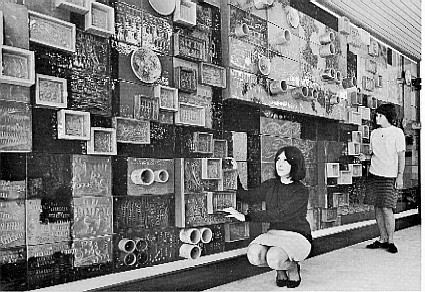- Screen Colours:
- Normal
- Black & Yellow
 The fabric of Christ Church URC in Tacket Street from Andrew Kleissner (Rev.), Cardiff
The fabric of Christ Church URC in Tacket Street from Andrew Kleissner (Rev.), Cardiff
I was browsing your website and came across the article Ipswich Rocks in the January newsletter [Issue 224]. As a former Minister of Christ Church – the former Congregational Chapel – in Tacket Street (2005-2017) I was pleased to see the building mentioned. However investigations carried out some years ago prove that appearances can be deceptive! The main structure of the building is in fact made of brick, with Kentish ragstone cladding and poor quality infill between the two. If you walk down the passage to the side of the similar Museum Street Methodist church (also Frederick Barnes) you will see the naked brick – clearly an economy measure as this wall cannot be seen from the front (which, since reordering, is now the back!)
You will know that many of the decorative features such as the twin spires above the entrance and the decorative parapets have long since disappeared, though the latter can (or could in 2017) still be seen on the building of the International Elim church (Barnes again) on Norwich Road. Sadly repair work using the wrong kind of hard mortar was carried out on the Tacket Street building, probably in the 1950s/60s, and this has had a detrimental effect on the stonework. Much conservation work has been done over recent years, with the elegant Rose Window facing Tacket Street being substantially recrafted about 10 years ago. At the time of my departure repairs were still outstanding to the western façade. There is an interesting ‘artist’s impression’ of the Tacket Street building hanging in the church’s office; this is slightly different to the church as built and does not have the later additions at the east end; I suspect this may have been an architect’s drawing to ‘sell’ the project to the congregation.
Tacket Street Congregational Chapel was mentioned by Dickens in one of his works – he didn’t like it as he felt it was far too fancy for a Nonconformist chapel:-
‘In Tacket Street stands a grand quasi-gothic edifice which would do credit to the most fanatical worshippers of medieval architecture. Such spires and such entrances, and all so new and clean: it is enough to put one’s eyes out; and as for the parish churches in the town, which are all more or less imposing in their aspect, they are reduced to utter insignificance by comparison with this gorgeous congregational chapel, for such indeed is the Tacket Street Temple.
‘So was the erection of this chapel a cause of universal triumph? Nothing of the sort: it was a cause of schism! Dissenters of the old school lamented the shabby chapel that once occupied the same spot and retreated in numbers from a building that savoured of Popery, while Christians of a more genteel kind were mostly pleased with their new edifice. The local newspapers took up the subject with immense spirit, and an imaginary dialogue between the old and new chapel is still remembered as a masterpiece of sarcasm.’
There is also a doggerel poem (worthy of McGonagall) in which a person buried in the chapel’s graveyard comes back to life, and is horrified to see the dear old Meeting House torn down and the monstrous new chapel built in its place. As the ghost is musing on this, a Catholic ghost hops over the wall from the newly-built St Pancras Church, claiming that it’s all part of a Catholic plan to take over – such were the fears of some Christians in the mid-19th century!
The Harvest mural, Ipswich Co-operative store from Merv Russen

I am a trifle concerned about the Co-op Harvest mosaic (see photograph) on the Co-op building overlooking the car park in Cox Lane. I believe the Society have had assurances that it will be saved and installed elsewhere.
Installation in the school precincts has been suggested – I hope this means it is still accessible to the general public – if it happens at all.
Ipswich Borough Council/Suffolk County Council have given those assurances in the past. An example was the Hutton ceramic mural commissioned by the former Eastern Electricity Board in Ipswich in 1966 for their new headquarters building in Russell Road (pictured below). This was apparently stored in boxes at the time of the demolition of the building and is now lost. I know it was not to everyone’s taste and of its time but that is not the point.

The Longship screens in the Old Cattle Market would have been lost if a group of like-minded people had not rattled some cages with the help of Mandy Gaylard.
I wonder if we could ensure that this valuable artefact does not also disappear – never to be seen again.
John Norman replies:
The Ipswich Society lobbied the consultants and the architects for the saving of the Harvest mural. All to no avail; the Planning Statement included in their application was that the mosaic was too difficult to remove, too expensive, impossible to save, is already damaged and firmly attached to the concrete frame of the building.
 Luckily the Councillors decided that it should be carefully removed and consideration given to its relocation in the new school.
Luckily the Councillors decided that it should be carefully removed and consideration given to its relocation in the new school.
Incidentally, I did remind both Councillors and consultants of the Geoffrey Clarke Eye (see photo). I organised the demolition of the tower block at Civic College but arranged with the contractor to remove the ‘concrete panel’ (wall section) containing the coloured glass window and cart it to Geoffrey Clarke’s studio in Hartest.
‘Harvest’ photograph courtesy John Norman.
John Hutton mural; photo from cover of an old Eastern Electricity booklet.
‘Eye’ by Geoffrey Clarke; photograph courtesy John Norman.